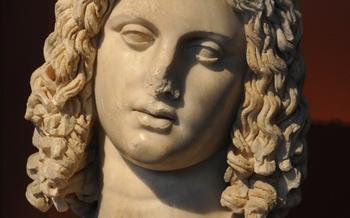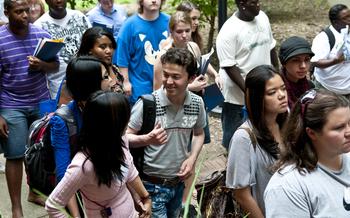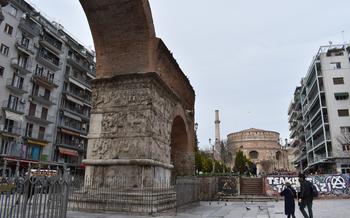
Paleochristian and Byzantine Monuments of Thessaloniki (UNESCO World Heritage Sites)
- The Rotunda: An Enduring Symbol of Resilience
- Hagia Sophia: A Masterpiece of Byzantine Architecture
- The Galerian Complex: A Glimpse into Imperial Grandeur
- Church of Panagia Chalkeon: A Hidden Gem
- Church of the Acheiropoietos: Divine Intervention in Stone
- Church of Agios Demetrios: A Patron Saint's Legacy
- Church of Agia Ekaterini: A Testament to Architectural Ingenuity
- Church of the Holy Apostles: A Sacred Legacy
- Thessaloniki International Film Festival: A Cultural Extravaganza
- Thessaloniki's Vibrant Food Scene: A Culinary Journey
- Insider Tip: Explore the City's Hidden Gems
The Rotunda: An Enduring Symbol of Resilience
The Rotunda is a magnificent architectural marvel that stands as a testament to Thessaloniki's rich history and diverse influences. Originally constructed as a Roman temple dedicated to the Emperor Galerius, this impressive cylindrical structure has undergone a remarkable transformation over the centuries. In the early Christian era, it was converted into a church, and its interior was adorned with stunning mosaics depicting scenes from the Bible.
The Rotunda's architectural brilliance lies in its simplicity and grandeur. Its massive dome, supported by eight arches, creates a sense of awe-inspiring spaciousness. The thick walls, constructed using bricks and mortar, have stood the test of time, enduring earthquakes and other natural calamities.
The exquisite interior of the Rotunda is a testament to the skill and artistry of Byzantine craftsmen. The walls are adorned with vibrant mosaics, depicting scenes from the life of Christ and the Virgin Mary. The intricate carvings and decorative elements add to the overall grandeur of this sacred space.
Today, the Rotunda serves as a popular exhibition space, hosting a variety of art and cultural events. Its unique blend of architectural styles and historical significance makes it a must-visit destination for anyone exploring Thessaloniki's UNESCO World Heritage Sites. Whether admiring the intricate mosaics, marveling at the architectural prowess, or simply soaking in the serene atmosphere, the Rotunda offers a truly immersive experience that transports visitors back in time.
Hagia Sophia: A Masterpiece of Byzantine Architecture
Hagia Sophia, a majestic edifice that once served as a Christian basilica, a mosque, and now stands as a remarkable museum, is a testament to Thessaloniki's rich history and architectural prowess. Dating back to the early 8th century, this awe-inspiring structure embodies the grandeur of Byzantine architecture.
Its imposing dome, a marvel of engineering, dominates the skyline and exemplifies the skill and ingenuity of Byzantine builders. The interior of Hagia Sophia is adorned with exquisite mosaics and frescoes that depict biblical scenes and historical events, showcasing the artistry and devotion of its creators.
The transformation of Hagia Sophia from a basilica to a mosque during the Ottoman era left an indelible mark on the building. Islamic elements, such as the minaret, blend harmoniously with the original Byzantine architecture, reflecting the city's diverse cultural heritage.
Today, Hagia Sophia serves as a museum, inviting visitors to marvel at its architectural splendor and immerse themselves in the rich history of Thessaloniki. It stands as a symbol of the city's resilience and its enduring legacy as a cultural and religious crossroads.
The Galerian Complex: A Glimpse into Imperial Grandeur
The Galerian Complex is a remarkable architectural ensemble that stands as a testament to the grandeur and power of the Roman Empire in Thessaloniki. Built during the reign of Emperor Galerius in the early 4th century AD, the complex comprises three distinct structures: the Rotunda, the Arch of Galerius, and the ruins of the Imperial Palace.
-
The Rotunda: This impressive cylindrical structure was initially constructed as a temple dedicated to Zeus, the supreme god of the Roman pantheon. However, with the arrival of Christianity, it was transformed into a Christian church, reflecting the changing religious landscape of the empire. The Rotunda's soaring dome, exquisite mosaics, and intricate carvings showcase the architectural prowess of its builders.
-
The Arch of Galerius: This triumphal arch was erected to commemorate Galerius's military victories over the Persians. Its intricate reliefs depict scenes of battle and conquest, glorifying the emperor's achievements. The arch stands as a symbol of Roman imperial power and military might.
-
The Imperial Palace: Although only ruins remain, the Imperial Palace once served as the opulent residence of Galerius and his court. Its grand halls, lavish decorations, and extensive gardens reflected the extravagance and splendor of the Roman imperial lifestyle. The palace ruins offer a glimpse into the grandeur and opulence that characterized the imperial court of Thessaloniki.
Church of Panagia Chalkeon: A Hidden Gem
Amidstia Chalkeon stands as a testament to the city's rich architectural heritage. This unassuming yet captivating edifice, tucked away in the heart of the Old Town, is one of the oldest surviving churches in Thessaloniki, dating back to the 11th century. Its unique architectural style, characterized by a blend of Byzantine and Ottoman influences, sets it apart from its more illustrious counterparts.
The church's exterior is a study in simplicity, with its unadorned brick façade and a small, unassuming entrance. However, its interior reveals a hidden treasure trove of Byzantine art and architecture. The walls are adorned with stunning frescoes depicting scenes from the life of Christ and the Virgin Mary, while the intricately carved iconostasis, a masterpiece of wood carving, is a testament to the skill of Byzantine artisans.
Dedicated to the Virgin Mary, Panagia Chalkeon holds a special place in the hearts of Thessaloniki's faithful. According to legend, the church was built on the site where a miraculous icon of the Virgin Mary was discovered, and it has been associated with numerous miracles and blessings throughout its history. To this day, the church remains an active Greek Orthodox place of worship, where locals and pilgrims alike come to seek solace, guidance, and divine intervention.
Whether you're a history buff, an architecture enthusiast, or simply someone who appreciates hidden gems, the Church of Panagia Chalkeon is a must-visit destination. Its unique blend of architectural styles, its historical significance, and its ongoing role as a place of worship make it a truly special and memorable experience.
Church of the Acheiropoietos: Divine Intervention in Stone
The Church of the Acheiropoietos, meaning "made without hands," holds a significant place in Thessaloniki's religious and architectural landscape. Its name stems from the legend surrounding the miraculous icon of the Virgin Mary housed within its walls. According to tradition, the icon was created by divine intervention rather than human hands, earning it the title "Acheiropoietos."
The church's origins date back to the 5th century, when it was constructed as a basilica. Over time, it underwent several modifications and expansions, resulting in the impressive Byzantine structure we see today. The church's exterior features intricate brickwork and decorative elements, while its interior boasts stunning mosaics and frescoes depicting scenes from the life of Christ and the Virgin Mary.
The main attraction of the Church of the Acheiropoietos is undoubtedly the revered icon of the Virgin Mary. Believed to possess miraculous powers, the icon has been a source of pilgrimage and devotion for centuries. Worshippers from far and wide flock to the church to seek blessings and pay homage to the sacred image.
Beyond its religious significance, the Church of the Acheiropoietos is also an architectural masterpiece. Its well-preserved mosaics and frescoes offer a glimpse into the artistic prowess of the Byzantine era. The church's serene atmosphere and intricate details create a truly awe-inspiring experience for visitors.
Today, the Church of the Acheiropoietos stands as a testament to the deep faith and rich cultural heritage of Thessaloniki. It remains an active place of worship and a popular destination for pilgrims and tourists alike, inviting visitors to immerse themselves in its sacred history and marvel at its architectural splendor.
Church of Agios Demetrios: A Patron Saint's Legacy
Thessaloniki's rich history and religious heritage are embodied in the Church of Agios Demetrios, a majestic edifice dedicated to the city's patron saint. Saint Demetrios, a Roman soldier martyred in the 4th century, is deeply revered by the people of Thessaloniki, who consider him their protector and intercessor. The church, built over his tomb in the 5th century, has undergone several transformations throughout history, evolving from a simple basilica to the grand Byzantine structure that stands today.
Inside, visitors are awestruck by the stunning mosaics, frescoes, and intricate carvings that adorn the walls and ceilings. These exquisite artworks depict scenes from the saint's life, his martyrdom, and the miracles attributed to his intercession. The church's grandeur is further enhanced by its impressive dome, which rises high above the city skyline.
Pilgrims from around the world flock to the Church of Agios Demetrios to pay homage to the saint and seek his blessings. The church also serves as a vibrant center of worship for the local Greek Orthodox community. Throughout the year, it hosts religious services, festivals, and processions honoring Saint Demetrios, attracting devout believers and curious visitors alike.
Church of Agia Ekaterini: A Testament to Architectural Ingenuity
Amidst the architectural wonders of Thessaloniki, the Church of Agia Ekaterini stands out for its unique and captivating design. Constructed in the 13th century, this remarkable church showcases a harmonious blend of Byzantine and Gothic elements, reflecting the city's rich cultural heritage. Its most striking feature is its octagonal dome, a distinctive characteristic that sets it apart from other religious structures in the city. The dome, adorned with intricate patterns and vibrant colors, creates an ethereal and awe-inspiring atmosphere within the church.
As you step inside Agia Ekaterini, you are greeted by a breathtaking interior adorned with vibrant frescoes and intricate carvings. The walls and ceilings are adorned with scenes from the Bible, depicting stories of faith, hope, and redemption. The vibrant colors and expressive figures bring the biblical narratives to life, creating a visually stunning and spiritually uplifting experience for visitors.
The Church of Agia Ekaterini holds a significant place in the religious history of Thessaloniki. It served as a cathedral during the Byzantine period and played a central role in various religious ceremonies and celebrations. Today, it continues to function as a Greek Orthodox church, welcoming worshippers and pilgrims from around the world. Its enduring legacy as a sacred space adds to its charm and significance.
Whether you are a history buff, an architecture enthusiast, or simply a traveler seeking spiritual enlightenment, the Church of Agia Ekaterini is a must-visit destination. Its unique architectural features, stunning interior, and historical significance make it a true gem in the crown of Thessaloniki's religious and cultural heritage.
Church of the Holy Apostles: A Sacred Legacy
Amidst the labyrinthine streets of Thessaloniki, the Church of the Holy Apostles stands as a testament to the city's rich architectural heritage. Dating back to the 14th century, this Byzantine masterpiece is dedicated to the twelve apostles of Christ and exudes an aura of sacredness and tranquility.
The church's architectural style is a harmonious blend of Byzantine and Gothic influences, showcasing the city's diverse cultural influences. Its most striking feature is the octagonal dome, which rests gracefully atop the main structure. The dome is adorned with intricate carvings and colorful frescoes, creating a visually captivating spectacle.
Inside, the church is a treasure trove of Byzantine art and iconography. The walls are adorned with vibrant frescoes depicting scenes from the Bible and the lives of the apostles. The meticulous attention to detail and the vibrant colors of these paintings transport visitors back in time, offering a glimpse into the artistic prowess of the era.
The Church of the Holy Apostles remains an active Greek Orthodox church, playing a vital role in the religious and cultural life of Thessaloniki. During religious festivals and services, the church's interior buzzes with activity as the local community gathers to pray and celebrate their faith.
For visitors, the Church of the Holy Apostles offers a unique opportunity to experience the spiritual essence of Thessaloniki and delve into the city's rich history. Its sacred atmosphere, exquisite architecture, and stunning artwork make it a must-visit destination for anyone interested in Byzantine culture and religious heritage.
Thessaloniki International Film Festival: A Cultural Extravaganza
Thessaloniki's vibrant cultural scene shines brightly with the annual Thessaloniki International Film Festival (TIFF), a prestigious event that has garnered international recognition and acclaim. Established in 1960, TIFF is one of the oldest and most respected film festivals in Europe, showcasing a diverse lineup of films from around the world, including premieres, retrospectives, and independent productions.
The festival's carefully curated program offers a unique opportunity to discover new cinematic voices, explore diverse perspectives, and engage with thought-provoking storytelling. Attendees can immerse themselves in the world of cinema through screenings, workshops, masterclasses, and panel discussions, gaining insights into the creative process and connecting with fellow film enthusiasts.
TIFF's impact on Thessaloniki's cultural landscape is undeniable. The festival attracts filmmakers, actors, and industry professionals from around the globe, contributing to the city's reputation as a vibrant hub for the arts. It also fosters a sense of community among local film lovers, providing a platform for cultural exchange and appreciation.
For those planning to attend TIFF, practical information is essential. The festival typically takes place in November, with screenings held at various venues across the city, including cinemas, theaters, and cultural centers. Ticket prices vary depending on the type of screening and the number of films you wish to see.
Whether you're a seasoned film buff or simply looking for a unique cultural experience, the Thessaloniki International Film Festival is an event not to be missed. Embrace the opportunity to immerse yourself in the world of cinema, discover new perspectives, and celebrate the art of storytelling in one of Greece's most vibrant cities.
Thessaloniki's Vibrant Food Scene: A Culinary Journey
Thessaloniki's culinary heritage is a testament to the city's rich history and diverse cultural influences. From traditional Greek dishes to international fusion cuisine, the city offers a culinary journey that will tantalize your taste buds.
Must-try local dishes include moussaka, a layered casserole made with eggplant, potatoes, and minced meat; souvlaki, grilled meat skewers served with pita bread, tzatziki sauce, and fresh vegetables; and bougatsa, a filo pastry filled with sweet or savory fillings.
To experience authentic Greek cuisine, head to the vibrant food markets, where you can find fresh produce, spices, and traditional delicacies. For a more upscale dining experience, try one of the many tavernas and restaurants scattered throughout the city. Don't forget to sample the local wines, beers, and spirits, which are renowned for their quality and flavor.
Navigating Thessaloniki's food scene can be overwhelming, but with a little exploration, you can find hidden gems and off-the-beaten-path eateries that offer unique culinary experiences. Don't be afraid to ask locals for recommendations or venture into the city's neighborhoods to discover hidden culinary treasures.
Insider Tip: Explore the City's Hidden Gems
Beyond the well-trodden tourist paths, Thessaloniki conceals a treasure trove of hidden gems waiting to be discovered. Venture into the atmospheric Ladadika district, where narrow cobblestone streets lined with charming tavernas, boutiques, and art galleries create a vibrant ambiance. As night falls, the area transforms into a lively entertainment hub, buzzing with locals and visitors enjoying the city's vibrant nightlife.
Ascend to the Ano Poli (Upper Town), the oldest part of Thessaloniki, perched atop the city's hills. This historic quarter boasts traditional architecture, narrow winding streets, and stunning panoramic views. Explore its hidden courtyards, adorned with colorful murals and blooming flowers, and uncover the stories etched into its ancient walls.
Seek out unique museums and galleries tucked away in unexpected corners of the city. Delve into the world of photography at the Thessaloniki Museum of Photography, showcasing works by renowned Greek and international artists. Discover the fascinating history of the city's Jewish community at the Jewish Museum of Thessaloniki. Immerse yourself in the vibrant contemporary art scene at the State Museum of Contemporary Art, housed in a striking modern building.
Embrace the spirit of exploration and let curiosity guide your footsteps as you uncover the hidden treasures of Thessaloniki. Engage with locals, wander through picturesque alleys, and stumble upon unexpected delights that will leave an enduring impression of this vibrant and multifaceted city.




